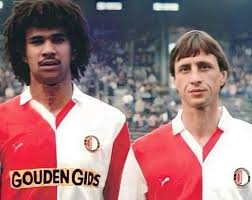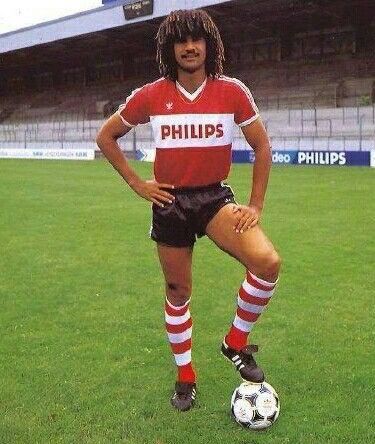Ruud Gullit, born Rudi Dil on September 1, 1962, is a celebrated figure in the world of football, renowned for his dynamic playing style and versatility on the pitch. A Dutch former footballer and manager, Gullit made his mark in the 1980s and 1990s as an attacking midfielder, forward, and defender. His illustrious career includes captaining the Netherlands national team to victory at UEFA Euro 1988, where his leadership was pivotal in securing the championship. Acknowledged as one of the Top 125 greatest living footballers by FIFA in 2004, Gullit transitioned from a successful stint at PSV Eindhoven to AC Milan in 1987 for a world record transfer fee, forming a formidable trio with Marco van Basten and Frank Rijkaard.
With three Serie A titles and two European Cups to his name, he later took on the role of player-manager at Chelsea, leading the club to its first major trophy in 26 years. Gullit’s accolades include the prestigious Ballon d’Or in 1987 and recognition as World Soccer Player of the Year in both 1987 and 1989, solidifying his legacy as one of football’s greatest.
HFC Haarlem: 1979-1982

Ruud Gullit began his professional career at HFC Haarlem, signing with the club on September 22, 1978, under coach Barry Hughes. Making his debut at just 16 years and 11 months old, he became the youngest player in Eredivisie history. Over his time at Haarlem, Gullit made 91 league appearances, scoring 32 goals. Although the team finished bottom of the league in his first season, they rebounded to win the Eerste Divisie the following year, with Gullit named the league’s best player. In the 1981–82 season, he helped Haarlem finish fourth, securing European qualification for the only time in the club’s history.
Feyenoord: 1982-1985

Ruud Gullit joined Feyenoord in 1982 after English clubs Arsenal and Ipswich Town passed on signing him. At Feyenoord, he made 85 league appearances, scoring 31 goals. In his second season, he played alongside the legendary Johan Cruyff, making a significant impact. Although his first season ended without major honors, the following year saw Feyenoord achieve a league and cup double, with Gullit named Dutch Footballer of the Year for his contributions. Transitioning to a more advanced midfield role, he faced challenges, including racial abuse from fans and controversy over comments made by his manager, which highlighted the racial issues of the time.
PSV Eindhoven: 1985-1987

In 1985, Ruud Gullit transferred to PSV Eindhoven for 1.2 million Dutch guilders, quickly making his mark by scoring 46 goals in 68 league appearances. His outstanding performance helped PSV secure the Eredivisie title in 1986, and they repeated this success the following year. It was during his time at PSV that Gullit solidified his reputation as a world-class footballer, with his distinctive dreadlocks drawing the attention of Europe’s top clubs. However, his move also attracted criticism from Feyenoord supporters, who labeled him a “wolf” and accused him of prioritizing financial gain over loyalty to his former club.
AC Milan: 1987-1994

Ruud Gullit signed with AC Milan in 1987 for a then world record transfer fee of 18 million Dutch guilders, joining the club during a pivotal moment in its history. Under the leadership of president Silvio Berlusconi, Milan aimed to revive its fortunes after years of stagnation. Gullit was joined by compatriot Marco van Basten and later by Frank Rijkaard, forming a formidable trio. His performances at PSV and Milan earned him the Ballon d’Or in 1987, which he dedicated to Nelson Mandela.
Initially, Gullit faced challenges adapting to life in Italy, struggling with the language and cultural differences. However, his first season culminated in Milan winning the Scudetto, their first league title in nine years, under coach Arrigo Sacchi. Gullit played a crucial role, initially positioned on the right of an attacking trio. Following van Basten’s injury, he transitioned to a front two, contributing significantly to the team’s success.
The following seasons saw Milan dominate European football, winning the European Cup in 1989, where Gullit scored two vital goals in the final against Steaua București. Despite suffering injuries that limited his playing time, he helped Milan retain the trophy in 1990. However, by the early 1990s, Gullit found himself increasingly sidelined under new coach Fabio Capello, as injuries and the introduction of a rotation system diminished his role. Eventually, after a series of injuries, he was loaned to Sampdoria, marking the end of an era at Milan.
Sampdoria: 1993-1995

In 1993, Ruud Gullit joined Sampdoria, where he enjoyed a successful stint, helping the team secure victory in the Coppa Italia during the 1993–94 season. One of his standout moments was scoring the winning goal in a thrilling 3–2 match against his former club, AC Milan. Although he was briefly re-signed by Milan in 1994, Gullit quickly returned to Sampdoria before the end of the 1994–95 season. During his time at the club, he played under future England national team manager Sven-Göran Eriksson, fostering a strong understanding and mutual respect. In total, Gullit scored 15 goals for Sampdoria.
Chelsea: 1995-1998

In July 1995, Ruud Gullit made a significant move to Chelsea on a free transfer, marking a new chapter in his career. Initially deployed as a sweeper by manager Glenn Hoddle, Gullit struggled to find his footing. However, once shifted to his preferred midfield role, he flourished, scoring six goals. His presence, along with signings like Mark Hughes and Dan Petrescu, propelled Chelsea to the FA Cup semi-finals, although they finished 11th in the Premier League.
In the summer of 1996, following Glenn Hoddle’s departure to manage the England national team, Ruud Gullit was appointed as Chelsea’s player-manager, becoming the first Dutch manager in Premier League history. He made a promising start, leading Chelsea to an FA Cup triumph in 1997, the club’s first major trophy in 26 years. This achievement made him the first manager from outside the British Isles and the first black manager to win a major British football trophy.
The following season saw Chelsea in second place in the league and progressing to the quarter-finals of two cup competitions. However, Gullit was unexpectedly sacked, reportedly due to a disagreement with the club’s board over compensation issues, a claim he contested. He was replaced by Gianluca Vialli, whom Gullit had brought to the club, and who later led Chelsea to UEFA Cup Winners’ Cup and Football League Cup victories.
Gullit’s final appearance as a player occurred in the first leg of that season’s League Cup semi-final against Arsenal, but he was dismissed before the second leg. His controversial sacking drew criticism, with chairman Ken Bates remarking on Gullit’s perceived arrogance, highlighting the tensions that can arise in football management. Despite the abrupt end to his tenure, Gullit’s impact on Chelsea and the Premier League was undeniable, paving the way for future international managers.
Netherlands: 1981-1994

Ruud Gullit made his debut for the Netherlands national team on his 19th birthday in 1981, coming on as a substitute in a match against Switzerland that ended in a 2–1 defeat. He soon emerged as a pivotal player for the Dutch squad, playing a crucial role in their triumph at UEFA Euro 1988 under coach Rinus Michels. After losing their opening match to the Soviet Union, the Netherlands bounced back, defeating England and the Republic of Ireland to reach the semi-finals. Gullit assisted Marco van Basten with two goals in a decisive 3–1 victory over England. In the final, Gullit scored the opening goal with a powerful header, leading the Netherlands to a 2–0 win against the Soviet Union. This victory marked a historic moment, as Gullit became the first Dutch captain to lift international silverware.
However, injuries plagued Gullit’s career in the early 1990s. At the 1990 FIFA World Cup, he struggled with knee issues but managed a vital assist against the Republic of Ireland. The Netherlands faced a disappointing exit, losing to West Germany in the knockout stage. At UEFA Euro 1992, Gullit played well but the team was eliminated by Denmark in the semi-finals after a penalty shootout.
In 1993, tensions arose between Gullit and manager Dick Advocaat, particularly after being played out of position. Although Gullit briefly returned to the national team, he ultimately walked out of the pre-tournament training camp before the 1994 World Cup, ending his international career on a sour note, despite his significant contributions to Dutch football.






















